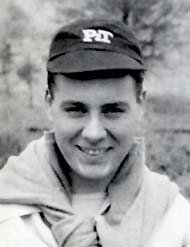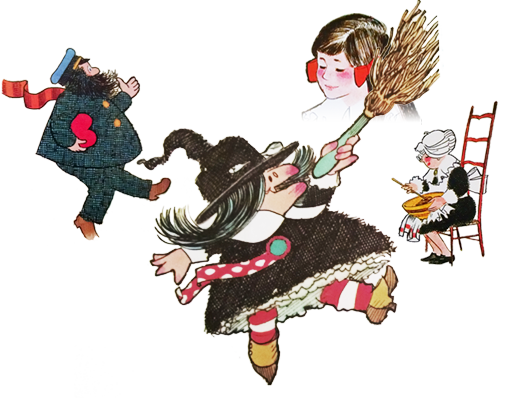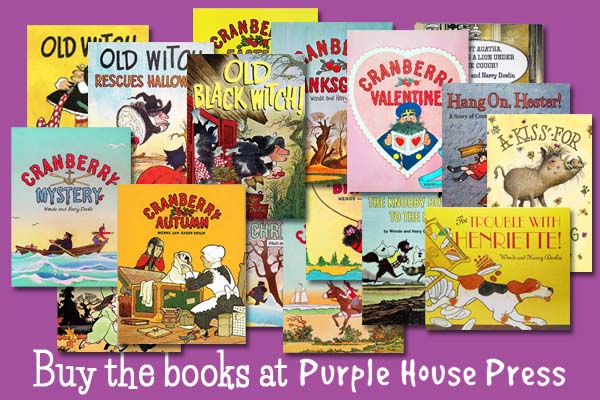Harry Devlin
“The author of 21 children’s books, three films, and countless cartoons for Collier’s magazine, Harry has spent a lifetime illustrating and illuminating the world around him.” – Taken from NJ Governor Thomas H. Kean’s introductory speech of Harry as Chairman of the 1989 Book Awards Committee
Harry was born March 22, 1918 in Jersey City, New Jersey, the second of two sons of Harry G. and Amelia Crawford Devlin. In 1922, his family moved to Elizabeth.

Harry Devlin, c.1930
When Harry was just eight years old, his artistic talent became evident. In the third grade at the William Livingston School in Elizabeth, a picture he drew on the blackboard so amazed the teacher that she brought the principal, Miss Seran to see it. A former teacher at Elizabeth’s Hamilton Junior High School, Kathleen Millar, remembered Harry as a shy but talented and creative twelve year old in a navy blue suit seated in the middle of the front row in her seventh grade art class. Indeed, if one were to pinpoint a beginning for Harry’s career as an illustrator, it probably would have been this moment, since the recognition he received led to a growing reputation for fine artwork.
In 1935, Harry graduated from high school. He then began attending Syracuse University, and majored in illustration. During his senior year he met his future wife, Dorothy Wende, known to her friends and family simply as Wende. She was then a junior from Buffalo, New York also majoring in Fine Arts.
In 1939, after completing his undergraduate studies, Harry moved to a studio in New York City. He soon found work illustrating stories written for the “pulp” magazines, publications generally consisting of brightly colored covers surrounding newsprint interiors.
His big break was a result of meeting an artist’s representative, M.Philip Copp, in need of an illustrator to do war drawings. Copp introduced Harry to Charles Tudor, art director at Life Magazine the publication chosen to prepare U.S. Army manuals, and Harry was immediately hired on a freelance basis. This work established his career and reputation. He was finally able to propose to Wende. They were married on August 30, 1941. Home for the Devlins after their marriage was in New York City, where Harry continued to illustrate the “pulps,” U.S. Army manuals, and managed to secure advertising commissions.
 On October 30, 1942, Harry began his active duty in the Navy as an Ensign. He was assigned to the Office of Naval Intelligence and assumed responsibility for all illustrations necessary for members of the armed services to identify enemy planes. With World War II at an end and Harry’s Navy enlistment over, the Devlins had to decide where to settle with their two children. They returned to Elizabeth, where Harry began what became a ten year association with Collier’s Weekly, a popular magazine which had begun publication in 1898. This association offered a chance at creative expression; an opportunity for Harry to design and paint relevant illustrations for magazine articles. The work at Collier’s was demanding.
On October 30, 1942, Harry began his active duty in the Navy as an Ensign. He was assigned to the Office of Naval Intelligence and assumed responsibility for all illustrations necessary for members of the armed services to identify enemy planes. With World War II at an end and Harry’s Navy enlistment over, the Devlins had to decide where to settle with their two children. They returned to Elizabeth, where Harry began what became a ten year association with Collier’s Weekly, a popular magazine which had begun publication in 1898. This association offered a chance at creative expression; an opportunity for Harry to design and paint relevant illustrations for magazine articles. The work at Collier’s was demanding.
Nevertheless, Harry was always looking for new challenges. In a short time, Harry Devlin became the leading editorial cartoonist at Collier’s. By 1950, Harry’s reputation as an editorial cartoonist was known throughout the publishing industry. Therefore, it is not surprising that as an expert in the field, he was asked to write the first chapter, “Making a Cartoon Tell the Story” for Illustrating and Cartooning, an instructional manual published in 1951.

The Devlin home and children in Mountainside drawn by Harry, c.1955
For Wende and Harry, this was a time of prosperity. Illustration truly was in its golden period, and Harry had almost more work than he could handle. From 1946 to 1955, in addition to his work for Collier’s, Harry illustrated the stories written each week by Bob Considine and Dorothy Kilgallen for the Saturday Home Magazine. During this time, the Devlin’s moved from Elizabeth to a charming mid-nineteenth century house and carriage house in Mountainside. Their seven children have memories of a childhood in which their parents presented the world to them as a wonderful place.
During the early 1950’s Harry also produced editorial cartoons for The New York Daily News. Unlike Collier’s, he developed his own themes and enjoyed the creativity of the experience. However; when the News asked Harry to print a cartoon in support of Senator Joseph McCarthy, Harry refused as a matter of principle, and was promptly fired. The trauma at the loss of his job did not compare with the feeling that always comes with the saving of conscience and integrity.
In 1954, Harry was named Vice-Chairman of President Eisenhower’s “People to People” Committee, and in 1956, he was elected President of the National Cartoonists Society. In 1986, he became the Society’s Honorary Chairman. Harry was also a life member of the Society of Illustrators.
By 1957, Collier’s Weekly was out of business, as television succeeded in taking over most of the advertising market that had formerly been the province of magazines and newspapers. For Harry, however, it began an artistic collaboration with Wende, that continued throughout their lives.
While Harry was making his mark as an illustrator and editorial cartoonist, Wende had been busy in her own studio. Her painted still lifes were winning prizes in New Jersey art exhibitions, and throughout her long career, she had never been without a portrait commission. In a recent example, Portrait of Gurlie Benou, Wende exhibits fine draftsmanship and the ability to capture the personality of the sitter. Harry also found portraiture a promising medium for his talent. Over the years, he has painted family, friends, and members of the community.
Portraits, however, were only one area of creativity shared by the Devlins. Wende’s talents were not limited to painting, but included a gift for writing, particularly clever and lighthearted comedy. Thus, the combination of Harry the illustrator and Wende the author was bound to produce an interesting collaboration. In 1954 they began the publication of “Fullhouse” also known as “Raggmopp”, a comic strip with characters named for their own six children; Wende, Harry (Herky), Brion, Jeff, Lexi (Alexandra) and Nicky [the seventh, David, was born in 1956]. The strips were based on the antics of the children – almost a documentation of their actual childhood.
Wende also created her own comic feature in the 1950’s featuring the friendly little girls Amy and Margie, and developed still another career writing the highly acclaimed “Beat Poems of a Beat Mother”, for Good Housekeeping Magazine. Harry soon developed an association with Parent’s Magazine Press, publishers of Calling All Girls, Humpty Dumpty’s Magazine for Little Children, and Children’s Digest, among others.
Looking back, it seems like an inevitable progression. From comic strips to children’s literature to children’s book illustration, Harry had found an important outlet not only for his talent, but also his whimsical sense of humor. In 1963, Wende wrote and Harry illustrated “Old Black Witch”, which along with its two sequels, have sold over one-and-one-half million copies. A long list of children’s books came in time, most were written by Wende and illustrated by Harry.
 In 1967, however, Harry began his own project when he authored as well as illustrated a book for young people describing and picturing examples of American architecture. Titled “To Grandfather’s House We Go: A Roadside Tour of American Homes”, it contains illustrations of paintings Harry had actually begun as early as 1954. Two years later, Harry completed his second architectural book for young people, “What Kind of a House is That?”.
In 1967, however, Harry began his own project when he authored as well as illustrated a book for young people describing and picturing examples of American architecture. Titled “To Grandfather’s House We Go: A Roadside Tour of American Homes”, it contains illustrations of paintings Harry had actually begun as early as 1954. Two years later, Harry completed his second architectural book for young people, “What Kind of a House is That?”.
In their later years, the Devlins concentrated their efforts on the Cranberry series of stories involving the ongoing activities of characters in a New England town. The first, “Cranberry Thanksgiving” published in 1971, captures the essence of a New England Thanksgiving in a house on the edge of a cranberry bog in the town of Cranberryport and even includes a touch of mystery involving a secret recipe. Illustrations include scenes similar to those many Americans can recall in their own celebrations of the holiday. The success of Cranberry Thanksgiving encouraged Wende and Harry to continue the theme and location as the context for celebrations and stories revolving around other important holidays. The books also continue the adventures of many of the same characters, while others are added.
The collaboration of the artistic and literary talents of Wende and Harry Devlin had not gone unnoticed in the academic and publishing worlds. In 1977, they shared Syracuse University’s highest alumni award, the George Arents Medal for Excellence in Art and Literature; and both were members of the New Jersey Literary Hall of Fame. They were great favorites at colleges and universities for conferences and symposia related to children’s literature. In 1985, Kean College of N.J. granted Harry an honorary doctorate of Humane Letters and in 1992, Rutgers University presented him with a Presidential citation.

Harry at his drawing board, c.1954
Over the years, Harry created illustrations for advertisers such as the Shell Oil Company, O’Mealia Advertising Corporation of Jersey City, New Jersey’s Public Service Electric and Gas Company and New Jersey Bell Telephone, Exxon, General Motors and Ford Motor Co. In 1983, he was inducted into N.J.’s Advertising Hall of Fame. He created six stamps for the U.S. postal service.
Harry devoted a significant amount of time to helping the State of New Jersey as well as local communities. From 1970 through 1979, he was a member of the New Jersey State Council on the Arts, and from 1984 through 1990, he served on the New Jersey Committee for the Humanities. In Mountainside, he was instrumental in arranging for the building of a new library, and he also used his artistic skills to support the United Fund of Westfield.
Harry had also been an active supporter of the Westfield Chamber of Commerce. In the early 1980’s, he began a series of scenes of Westfield that were produced in limited editions of 200 signed and numbered prints. A depiction of the business district of Westfield along with other local landmarks complete the series.
In 1977, Louis Presti, a film director, invited Harry to write and host a series of films on domestic architecture for New Jersey Public Broadcasting [New Jersey Network]. Given the overall title, Fare You Well, Old House, they include The Pattern Ended Houses of Salem County, Dutch Houses of Hackensack Valley and The Federal Houses of Princeton.
In 1989, Harry Devlin authored and illustrated “Portraits of American Architecture: Monuments to a Romantic Mood, 1830-1900”. The culmination as well as the documentation of Harry’s lifelong love of American architecture, Portraits of American Architecture presents a collection of his paintings and studies within the context of “the history of the era and the fascinating mood in which its buildings were conceived.”. It was republished by Random House in 1996.
Harry’s architectural paintings reveal his sociable and warm personality, which invites the viewer to take a closer look and perhaps even enter the buildings. Harry’s painting, Cape May Antiques I, presents a street devoid of figures with a single barber’s pole in the doorway.
However, the store is clearly identified; an open sign hangs in the window; and the door is ajar inviting entry to visiting shoppers and clearly implying the presence of additional figures within. Originally Harry painted a figure entering the store, but removed it when he realized that it was drawing too much attention from the building, the main subject of the work. In its place, he installed the barber’s pole. This decision to delete the figure was made in a positive sense related to a desire to improve the composition.
Harry Devlin’s style has been described as “contemporary Photo-Realism”, although it is also clear that H arry arrived at his artistic solutions independently. The style is acknowledged neither to impose restrictions on artists nor to imply a lack of selectivity. Generally, it calls for more than mere reproduction and goes beyond basic realism.
arry arrived at his artistic solutions independently. The style is acknowledged neither to impose restrictions on artists nor to imply a lack of selectivity. Generally, it calls for more than mere reproduction and goes beyond basic realism.
The body of work created by Harry Devlin spans the range of American architectural history. Here are only a few examples of his many architectural styles. The house in the painting is actually a relatively new structure located at Murray Hill Square, a reproduction of a mid-nineteenth century village located in a section of New Providence, New Jersey. Harry’s painting removes the house from its surroundings and places it alone on farmland, as he imagined the source for the structure would have originally appeared. The sunflower gives the composition added romantic appeal as he had again used the license of the Photo-Realist to make important artistic decisions.

Off the Yellow Brick Road, 1989
To Harry Devlin, Portraits of American Architecture described in visual form the sum total of his artistic experience. Not simple transcriptions of existing structures, they require the artistic expertise and historical, sociological and cultural knowledge necessary to create the several forms of illustration for which he had become widely known. These works also represent the form of painting that gave him the most pleasure – the one that expressed his love of architecture and fulfilled his vow made a half-century ago to one day “recapture the mood and ambiance of an architectural epoch so thoroughly maligned.” Harry Devlin had done much of what most of American has failed to do: Preserve and honor America’s heritage by capturing its unique and beautiful architecture on his canvases.
from Harry Devlin: A Retrospective by Barbara J. Mitnick, Ph.D.

See also: Wende Devlin.


